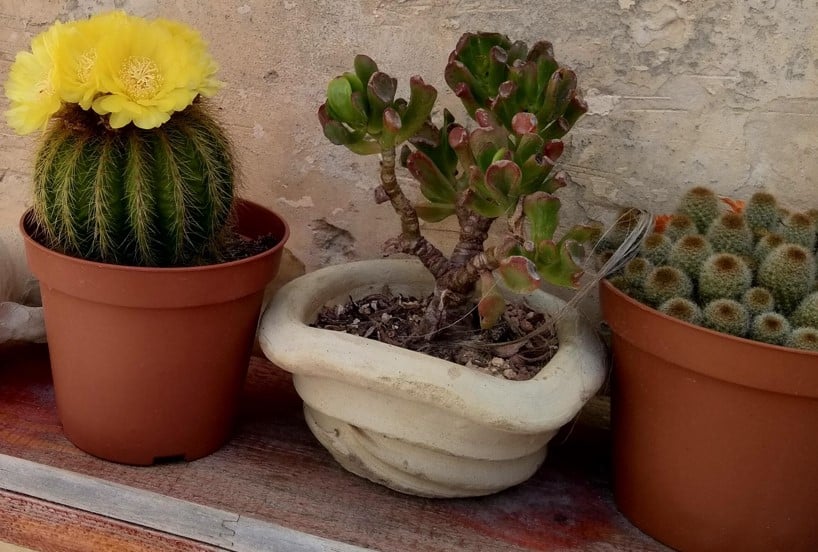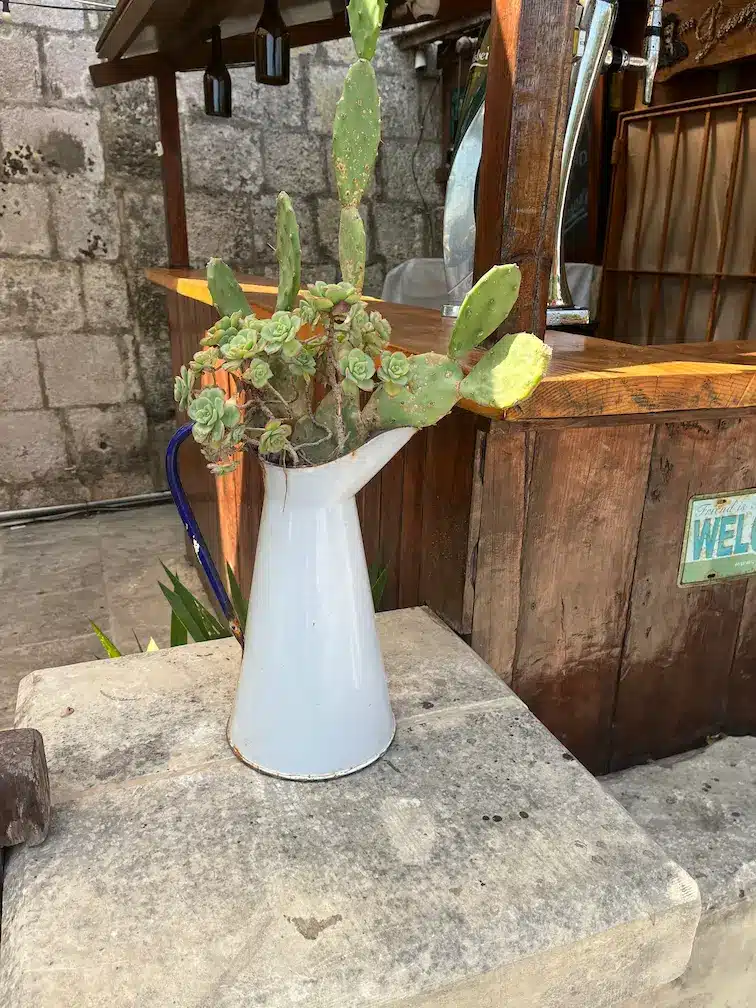
In nature, plants grow freely, so having them in pots is, in a way, rather unnatural. Some plants are very forgiving and accept any sort of container as a home, while others are extremely picky where the slightest discomfort in any of many conditions may have fatal consequences. Therefore, below, we reveal the types and sizes that exist. Take note!
Best pots for plants and succulents
A natural lifestyle with plants and decorating our home is timeless and enhances any style, from boho to minimalist or classic. However, choosing the best pots or containers is crucial in order to optimize the comfort and care for the plants. The pots are almost as important as choosing the species.
Plant Pots – a great diversity
The shapes, colors, and sizes of pots are endless, but ultimately, they all serve the same function: being a container in which plants are cultivated for their proper development. The pots will be their future home, and if we want to enjoy their good company, it is important to consider some tips that we will provide below.
Pots with or without holes? In general, it is preferable to have succulent pots with holes to facilitate drainage; otherwise, the roots are at risk of rotting. However, there is an exception: aquatic plants. It is preferable to cultivate them in pots without holes since they, unlike succulents, can never dry out completely.
Pot size
The perfect pot size varies greatly. Since there is a huge variety of pots, with lots of room for endless creativity – almost. Generally, our advice is to choose a container that is slightly larger than the size of the plant at that moment, about 3-5cm in diameter more than its current size. However, every plant lover should avoid exceeding the size of the pot in relation to the plant because it is one of the main causes of plant death. For example, if the plant is large, look for a container in which it feels comfortable and has the possibility to continue growing. On the other hand, if the plant is small, do not place it in a huge pot.
If you have a seasonal plant and anticipate very rapid growth, the pot should consequently be large enough to accommodate the future need.
If you choose a small plant in a large pot, the roots will eventually rot due to excessive substrate and moisture. Conversely, if you transplant a large plant into a small pot, its roots will not find enough space, and it will eventually die. We definitely want to avoid such dramas!
Best pots for succulents
The best pot size for succulents is generally slightly larger than the plant. Since its typically a slow grower which thrives in often poor soil without much nutrition. In the wild, succulents can develop roots in tiny cracks of a rock or other seemingly inhospitable environments, which they consider to be luxury apartments. Also, smaller pots will dry out quicker which always is beneficial for succulent plants, especially indoors without a natural breeze. Always consider at what pace the soil will dry out when planting a succulent – if the answer is “quickly”, you are most likely doing the right thing. For example, a coffee mug made form paper is a perfect home for the extremely drought-tolerant Living stones (in this case: Pleiospilos below).

When to repot a succulent?
Repot succulents every second or third year, depending on how much they grow. The best time to repot is just before the growing season. Never repot in the middle of the growing season since it will disturb the plant’s natural cycle.
Do succulents prefer deep or shallow pots?
Shallow pots are usually the best option since succulents prefer to dry out completely and fast. Of course, if you have a massive succulent, you’ll need a robust and appropriate sized pot. Cactus pots are even more crucial to have great drainage and allow for the soil to dry out, especially if located indoors.
Creative pots – DIY flower pots
Creative pots can be created from almost anything with a creative mind and vivid imagination. You can impress on your neighbors with your free-spirited garden that tickels the imagination. It is more than just a garden, it is a place for both relaxation and mental stimulation. For example:
- Old worn-out boots with a drainage hole can be used as a pot.
- If you are naturally artistic, you can paint the pots with unique shapes and colors and give them profound meaning and life.
- You can decorate an outside wall with shelves and hangers covered with decorative plants.
- Perhaps an old kettle or other worn-out kitchen appliances with some empty space inside could become a planter.
- 3D-print your dream flower pot.
- Print an image on a flower pot.
- An old bathtub, or an old toy pickup-truck with a storage box can now become a planter for flowers.
- Creative ideas for flower pots are infinite and up for grabs.
Types of pots
Generally, we categorize the materials from which pots are made into 7 categories: clay pots, ceramic pots, plastic pots, geotextile, coconut fiber pots, pulp paper pots, and fiber-cement pots.
Clay pots - Terracotta pots
Clay pots or Terracotta pots (which means “cooked earth” in Italian) are the most classic and sustainable pots, and they have been used for thousands of years. Made from natural raw materials such as clay or mud and minerals, their excellent porosity allows excess water that may accumulate inside to be released, thus preventing root rot. They also have an insulating effect, preventing cold in winter and heat in summer. You can find them in multiple shapes and sizes, and their aesthetic will blend with any style. As disadvantages, they are more expensive, heavier, and fragile.
Cacti and succulents thrive well in these pots, both indoors and outdoors, as they allow their roots to exude excess moisture and, at times, absorb moisture from the environment if needed, thanks to their porosity.
Best pots for succulents indoors should preferably not be made of plastic, since the material doesn’t breath and the ventilation is almost none.
Ceramic pots
Ceramic pots are also made from natural clays like terracotta, but they are fired at a different temperature and have a glazed finish. Although they are less porous, they still have the insulating effect provided. Despite being less porous, they still retain the natural insulating effect of the material, making them suitable for a wide range of plants. Another common option is to use them as decorative secondary containers: placing the plant in a plastic pot and covering it inside a glazed upper pot. It will create an ideal setting in any corner!
This is not suitable for succulents since may cause the plant to stand in water and prevent the plant from drying out quickly.
Mini pots for small plants
If we already have baby plants that don’t look very aesthetically pleasing in their current plastic pots, we shouldn’t miss the opportunity to acquire mini pots, perhaps in various colors.
Plastic pots
Plastic pots are the most commonly used due to their affordability and lightweight. They can be found everywhere: nurseries, plant stores, supermarkets, balconies, terraces, and more. However, they do have some disadvantages: they are more environmentally harmful, they overheat under the sun (in warm climate), they don’t evaporate excess water, they have a limited lifespan, and lastly, they are less visually appealing. On the other hand, they are very useful for accommodating large specimens such as shrubs, palms, fruit trees, or tropical plants. We do not recommend them for cacti and succulents. They are often sold in plastic pots which is usually fine, but when the time comes to repot we strongly advice a different choice of pot.
Geotextile pots
These containers are made from synthetic textiles and behave very similarly to coconut fiber planters. They are highly porous and permeable, and they are commonly used for creating vertical gardens. Highly malleable, you may have also seen them used for storing plants in pockets. We recommend their use for cacti, succulents, and epiphytic plants that do not require substrate in nature.
Self-Watering pots
Incredible as it may seem, self-watering pots exist today, making our lives easier. With these planters, we forget about watering our plants for days because they contain a water reservoir that gradually irrigates them on our behalf. They are the best choice if you tend to forget about watering.
Coconut Fiber Planters
These containers are made of interwoven coconut fiber. They are extremely porous, eco-friendly, and often used as pot holders. When used as planters, their usage should be limited to plants that require little watering and have well-draining soil, as water easily escapes through the coconut fibers. They are ideal for succulents, especially those sensitive to excess water. They can also be used as an alternative to plastic in nurseries, but with a short usage period.
Ceramic pots are also made from natural clays like terracotta, but they are fired at a different temperature and have a glazed finish. Although they are less porous, they still have the insulating effect provided. Despite being less porous, they still retain the natural insulating effect of the material, making them suitable for a wide range of plants. Another common option is to use them as decorative secondary containers: placing the plant in a plastic pot and covering it inside a glazed upper pot. It will create an ideal setting in any corner!
This is not suitable for succulents since may cause the plant to stand in water and prevent the plant from drying out quickly.
Paper Pulp pots
These planters are generally used for sowing seeds and other delicate species that cannot tolerate transplantation. Made from biodegradable paper pulp, they are a good option for direct planting.

Fiber Cement pots
Fiber cement planters and flower boxes are commonly referred to as “gardeners” and are frequently used in balconies, terraces, and urban furniture. They are more resistant and durable, manufactured in large formats, and offer superior thermal insulation.
